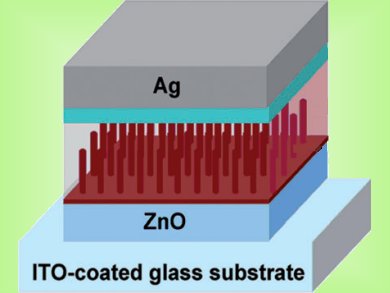Charge generation and transport play equally important roles in determining the efficiency of polymer-based organic solar cell devices. The transport distance of excitons is decreased by including bulk heterojunctions (BHJ), but the pathways are disordered and free charges are likely to encounter an opposite charge. This results in charge recombination and reduced current.
Yuh-Lin Wang and colleagues, National Chiao Tung University, Taiwan, have developed a new active-layer configuration. The poly(3-hexylthiophene):fullerene-based BHJ upper layer was deposited on a bottom layer with vertically oriented nanorods to create a well-organized nanostructured interface. The high charge generation and straight electron transport pathways allowed the solar cell to achieve a power conversion efficiency of 7.3 %. This is the highest value reported for poly(3-hexylthiophene):fullerene-based BHJ solar cells.
Image: © Wiley-VCH
- Enhanced Performance and Stability of a Polymer Solar Cell by Incorporation of Vertically Aligned, Cross-Linked Fullerene Nanorods
C.-Y. Chang, C.-E. Wu, S.-Y. Chen, C. Cui, Y.-J. Cheng, C.-S. Hsu, Y.-L. Wang, Y. Li,
Angew. Chem. Int. Ed. 2011.
DOI: 10.1002/anie.201103782



